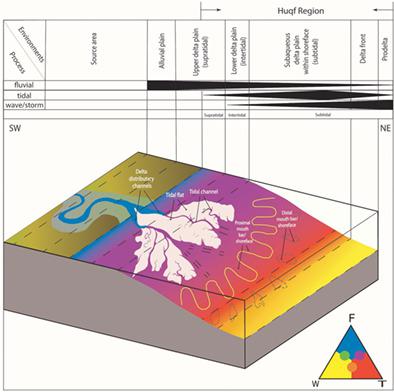当前位置:
X-MOL 学术
›
Geolog. J.
›
论文详情
Our official English website, www.x-mol.net, welcomes your
feedback! (Note: you will need to create a separate account there.)
Facies architecture and depositional model for a fine-grained hybrid-energy delta: An example from the Upper Cambrian to Lower Ordovician Barik Formation, Central Oman
Geological Journal ( IF 1.4 ) Pub Date : 2021-05-13 , DOI: 10.1002/gj.4157 Olga I. Shelukhina 1 , Mohamed A. K. El‐Ghali 1, 2 , Iftikhar Ahmed Abbasi 1 , Junaid Ahmed Khan 3 , Mohamed Kh. Khalifa 4 , Sankaran Rajendran 5 , Abdulrazak Al‐Sayigh 1
Geological Journal ( IF 1.4 ) Pub Date : 2021-05-13 , DOI: 10.1002/gj.4157 Olga I. Shelukhina 1 , Mohamed A. K. El‐Ghali 1, 2 , Iftikhar Ahmed Abbasi 1 , Junaid Ahmed Khan 3 , Mohamed Kh. Khalifa 4 , Sankaran Rajendran 5 , Abdulrazak Al‐Sayigh 1
Affiliation

|
Recognizing ancient deltas' depositional architecture is challenging due to the complex interplay of the fluvial, waves, and tidal processes. The integration of field-based sedimentological and trace fossils studies of the Late Cambrian-Early Ordovician Barik Formation in Central Oman allowed better identification of different lithofacies architectures and depositional process signatures. The Barik Formation is a major tight-gas reservoir in the Oman Sedimentary Basins, where it is over 800-m thick. The only outcrop analogue is in the Qarn Mahatta Humaid area, where ca. 50-m thickness of the formation is exposed and extends laterally over 5 km. This study revealed the presence of four lithofacies associations, including (a) mouth bar/shoreface, (b) tidal flat, (c) tidal channel, and (d) delta distributary channels using 12 logged sections. The depositional features identified in the field include tidal, wave/storm, and fluvial. The tidal signatures are represented by mud-drapes, large-scale reactivation surfaces, sigmoidal cross-bedding, and climbing and flaser bedding, predominantly in the mixed mud-sand tidal flats of the lower delta plain and delta distributary channels of the upper to lower delta plains. The wave/storm signatures are represented by wave ripples and small-scale hummocky cross-stratification in the mouth bar/shoreface of the delta front platform. The fluvial and subaerial signatures are represented by the occurrence of the scour surfaces with lag deposits of channel-fill and the development of desiccation mud-cracks. The Barik Formation delta sandstones form amalgamated sheet-like bodies prograding to the north-northeast and deposited along a ramp-type low relief basin. This prograding delta represents a highstand system tract. This study presents an example of the ancient fine-grained hybrid-energy prograding delta, where fluvial processes operated beside the tidal and wave/storm processes over a broad and low relief shelf in a vegetation-free system.
中文翻译:

细粒混合能源三角洲的相结构和沉积模型:以阿曼中部上寒武统到下奥陶统 Barik 组为例
由于河流、波浪和潮汐过程的复杂相互作用,识别古三角洲的沉积结构具有挑战性。阿曼中部晚寒武世-早奥陶世 Barik 组基于实地的沉积学和痕量化石研究的整合,可以更好地识别不同的岩相结构和沉积过程特征。Barik 组是阿曼沉积盆地的一个主要致密气藏,其厚度超过 800 米。唯一的露头类似物是在 Qarn Mahatta Humaid 地区,大约在那里。50 米厚的地层暴露在外,横向延伸超过 5 公里。本研究使用 12 个测井剖面揭示了四种岩相组合的存在,包括 (a) 河口坝/滨面、(b) 潮坪、(c) 潮汐河道和 (d) 三角洲分流河道。在现场确定的沉积特征包括潮汐、波浪/风暴和河流。潮汐特征以泥帘、大面积再活化面、S形交错层理、爬升和弗拉瑟层理为代表,主要分布在下三角洲平原的泥砂混合潮滩和上下游三角洲分流河道。三角洲平原。波浪/风暴特征由三角洲前缘平台的河口坝/岸面中的波浪涟漪和小规模的丘状交叉分层表示。河流和地下特征表现为冲刷面的出现以及河道填充的滞后沉积物和干燥泥裂的发展。Barik 组三角洲砂岩形成混合片状体,向东北偏北方向推进,并沿斜坡型低地势盆地沉积。这个进积三角洲代表了一个高位系统区域。本研究展示了古代细粒度混合能源进积三角洲的一个例子,在该三角洲,在无植被系统中,在宽阔而低矮的浮雕大陆架上,除了潮汐和波浪/风暴过程之外,还有河流过程。
更新日期:2021-05-13
中文翻译:

细粒混合能源三角洲的相结构和沉积模型:以阿曼中部上寒武统到下奥陶统 Barik 组为例
由于河流、波浪和潮汐过程的复杂相互作用,识别古三角洲的沉积结构具有挑战性。阿曼中部晚寒武世-早奥陶世 Barik 组基于实地的沉积学和痕量化石研究的整合,可以更好地识别不同的岩相结构和沉积过程特征。Barik 组是阿曼沉积盆地的一个主要致密气藏,其厚度超过 800 米。唯一的露头类似物是在 Qarn Mahatta Humaid 地区,大约在那里。50 米厚的地层暴露在外,横向延伸超过 5 公里。本研究使用 12 个测井剖面揭示了四种岩相组合的存在,包括 (a) 河口坝/滨面、(b) 潮坪、(c) 潮汐河道和 (d) 三角洲分流河道。在现场确定的沉积特征包括潮汐、波浪/风暴和河流。潮汐特征以泥帘、大面积再活化面、S形交错层理、爬升和弗拉瑟层理为代表,主要分布在下三角洲平原的泥砂混合潮滩和上下游三角洲分流河道。三角洲平原。波浪/风暴特征由三角洲前缘平台的河口坝/岸面中的波浪涟漪和小规模的丘状交叉分层表示。河流和地下特征表现为冲刷面的出现以及河道填充的滞后沉积物和干燥泥裂的发展。Barik 组三角洲砂岩形成混合片状体,向东北偏北方向推进,并沿斜坡型低地势盆地沉积。这个进积三角洲代表了一个高位系统区域。本研究展示了古代细粒度混合能源进积三角洲的一个例子,在该三角洲,在无植被系统中,在宽阔而低矮的浮雕大陆架上,除了潮汐和波浪/风暴过程之外,还有河流过程。











































 京公网安备 11010802027423号
京公网安备 11010802027423号